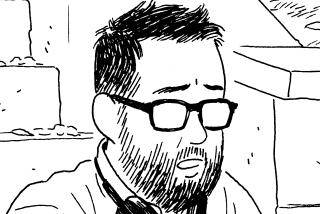Quirky slices of art, love and life
Juvenile, low-tech, edgy, cultish -- such is the world of zines, low-circulation, self-published magazines produced mostly by artists or others in their teens and 20s.
The Orange County Museum of Art has installed an exhibition of zines in a natural setting, a room that looks like a basement, at its satellite gallery in South Coast Plaza.
“What’s so wonderful about the space is it’s got a window onto the entrance of the mall,” said the museum’s curator of contemporary art, Irene Hofmann. “You’re invited to sit down and read these things. They’re not precious or valuable and you can spend time looking through them.”
The show originated at the Cranbrook Academy of Art in Bloomfield Hills, Mich., and included zines from the institute’s students and alumni.
But Hofmann sent out a plea for more zines to be added and now a collection of hundreds has been rotated through the space.
Visitors can choose from zines hanging on clotheslines and take them to one of two Naugahyde couches in the gallery.
Flip through STDT (the Super Ted Danson Tribune). Its cover photo of the celeb looks lifted from the National Enquirer. Read on to learn “Whoopi Goldberg’s Shocking Secret,” or “10 Things I Hate About Ted Danson,” or Ted Danson’s Guide to Manliness (chest hair, jewelry, big hair, cocky remarks). It’s a trove of info on the celebrity, much of it seemingly fic- tion.
And there’s Fertile Ground, the zine for people who dig parenting. The publishers detail the birth of their son Satchel, write poems about the virtues of mommy-and-daddyness, profile a “child-care goddess” and give tips for decorating the nursery. Its taupe cover is about as heavy as construction paper and the typeface looks as if it came straight from a five-generations-ago computer.
Tori AMOS fans won’t want to miss Choirgirl Powder. It’s a tiny yellow book with a fuzzy face of Amos surrounded by metallic stick-on stars -- the kind little kids who do well on their homework get from the teacher -- on the cover. It’s about the size of a pocket diary, which it pretty much turns into as the publisher-writer expounds on how she felt when she bought the single “Bliss.”
Zines, which have their roots in fan magazines (fanzines), range wildly in look and content. At times their purpose is a study, a working out of ideas by an artist. Other zines are written for an inner circle of readers who exchange ideas, photos and cartoons. But that circle is small and far from exclusive; it may be artsy but is by no means comparable to the Neue Zeitschrift fur Musik, that small-circulation 19th century publication in which Schumann wrote reviews of his friend Brahms’ music.
Some scrape the lower end of the gutter. Geek Monthly reviews porn movies and CDs with column mugs of the critics appearing in wild cartoon portraits.
“A lot of imagery reflects the age and cultural references of people who grew up in the ‘70s and ‘80s. Some of the cartoons have a certain influence of Japanese anime. Often the imagery reflects pop culture,” Hofmann said.
Spend time with many of the zines and a thread of American alternative-weekly-style cartooning seeps through -- the influence of Robert Crumb, Big Daddy Roth and other lowbrow artists pops up again and again.
Some zines have no text at all. One book of sketches bound with pink yarn tells a sinister tale. Bold drawings trace a little girl in a gingham dress, a threatening figure with fake fur hands, another girl, or perhaps an animal, carrying an ax, and a final scene of a hooded cloak hanging on a hook. The impression left is a twisted version of the Little Red Riding Hood story.
Another with glossy pages and Spanish text contains photos elaborately and artistically manipulated through a computer editing program. Photos of the human body and prose and poetry explore themes of mad love, paganism and the criminal mind.
No matter the subjects of the zines, a commonality reveals itself: They’re all uncensored in their texts and homemade in design.
“It’s a more democratic way of expression that goes back quite far,” said Hofmann. “It’s a link to our history. It’s about being able to share ideas and artwork and concepts. What’s so surprising is it’s so low-tech and it doesn’t need to be. They could be slick, but they deliberately choose not to be, and I think that tells us so much about who these people are.”
*
Zine scene
What: An interactive exhibition on zines
Where: Orange County Museum of Art’s satellite gallery in South Coast Plaza, 3333 Bristol St., Costa Mesa
When: 10 a.m.-7 p.m. today and Friday; 11 a.m.-6:30 p.m. Saturday and Sunday.
Info: (714) 662-3366
More to Read
The biggest entertainment stories
Get our big stories about Hollywood, film, television, music, arts, culture and more right in your inbox as soon as they publish.
You may occasionally receive promotional content from the Los Angeles Times.










